Viola baxteri House
Common names:
Baxter's Violet
Synonyms:
Viola baxteri House, Bull. New York State Mus. Nat. Hist. 254: 500. 1924. [replacement name for Viola perpensa sensu House non Greene]. TYPE: USA, New York, Ontario Co.: Fishers, 3 Jun 1916, H. D. House & M. Baxter s.n. (LECTOTYPE (designated by Ballard et al. 2020. Journal of the Botanical Research Institute of Texas 14(2): 219): NYS33489, image!).
Description:
Acaulescent rosulate perennials from thick rhizome, ≤ 24 cm tall; foliage and peduncles green, not purple-tinged, mostly moderately to densely hirsute; stipules free, irregularly glandular-fimbriate; homophyllous, leaves ascending, smallest leaf blades palmatifid, largest deeply biternately to subtriternately divided into 9–13(15) narrowly linear-lanceolate lobes < 3 mm wide (in chasmogamous flower), the lateral lobes of the terminal primary division attached medially, most ultimate lobes with a prominent slender spreading sharply acute tooth or short lobe on each side, primary divisions commonly narrowed at base to slender "petiolules", ≤ 69 × 82 mm, outline narrowly ovate to ovate during chasmogamous flower but broadening to broadly ovate or reniform in fruit, base (sub)cordate, margins of the lateral and often central second-order segments of the terminal primary division and sometimes of the lateral primary divisions with a prominent spreading slender sharply acute tooth or short lobe on each side, eciliate or ciliate, apex acute to obtuse; chasmogamous peduncle held among the leaves; chasmogamous flower ≤ 21 mm; calyx glabrous, ciliate; lowest sepals oblong to ovate, obtuse to rounded (rarely broadly acute); auricles short and entire, not or scarcely elongating in fruit; corolla blue to purple, throat white; spur short-globose; lateral petals densely bearded with slightly clavate hairs, spurred petal glabrous (occasionally sparsely bearded); chasmogamous capsule green; cleistogamous flowers produced after chasmogamous, peduncle prostrate, arching just before dehiscence, shorter than petiole; cleistogamous capsule 6–7 mm, green drying tan with purple spots or blotches, glabrous; seeds 1.6–2.3 × 1.1–1.6 mm, ivory, unspotted or with small weak light brown streaks or blotches.
Similar species:
The most extreme form of this species has the leaf blades biternate with the ultimate leaf divisions or segments narrowly linear and nearly as slender as those found in V. pedatifida. It shares with V. stoneana (a heterophyllous member of the Palmata species group) the unusual feature in Borealiamericanae violets of pale unspotted or weakly blotched seeds. It is most similar to other homophyllous cut-leaved taxa in the Pedatifida and Subsinuata species groups. Aside from the pale seeds, this species can be separated from V. brittoniana and V. pedatifida by its densely hirsute foliage, short rounded auricles, oblong or narrowly ovate ciliate obtuse to rounded sepals, glabrous spurred petal, and heavily spotted cleistogamous capsule on short prostrate peduncle. It differs from V. monacanora in its densely hirsute foliage, and oblong or narrowly ovate ciliate obtuse to rounded sepals. It can be distinguished from V. subsinuata by the several features of leaf dissection noted in the key, as well as the seed features. It is easily separated from V. tenuisecta in its densely hirsute foliage, biternately divided leaf blades, and oblong or narrowly ovate ciliate obtuse to rounded sepals.
Ecology:
Sandy or rocky loam of limestone prairies and prairie-like openings, often surrounded by richer mesic or swamp forest.
Distribution:
Mostly eastern Great Lakes region, c. NY to sw. ON and se. MI, s. to sw. PA, sw. OH, e. IN and n. KY.
Rarity:
State listed in OH.
Phenology:
Chasmogamous flower April-May (July), chasmogamous fruit May-June, cleistogamous fruit June-September.
Affinities:
This species belongs to the Acaulescent Blue Violet lineage, sect. Nosphinium, subsect. Boreali-Americanae (W.Becker) Gil-ad, in the Subsinuata species group.
Hybrids:
Hybridizes with V. affinis (Brainerd 1924, Haines et al. 2011), V. fimbriatula (House 1917, House 1924, Brainerd 1924 in part), V. sagittata (Harvey Ballard pers. comm.), and V. sororia (Brainerd 1924, Harvey Ballard pers. comm.). Other hybrids are surely possible over the broad regional zone of sympatry and should be sought. Hybrids studied thus far have intermediate or recombinant characteristics of foliage, chasmogamous flowers, cleistogamous capsules and seeds (where these did not abort). They fail to reproduce by chasmogamous flowers, and cleistogamous capsules produce a substantially reduced proportion of viable seeds.
Comments:
House (1918) initially identified plants "On shaded hillsides and moist woodlands which become dry in summer" from Rochester, New York as Viola perpensa Greene and cited two separate collections. Later (House 1924) he noted that that name Viola perpensa represented midwestern hybrids of V. pedatifida and V. sororia, and he provided the replacement name V. baxteri for the New York plants. Subsequently, he cited an earlier article (Bull. NY State Mus. 243–244:11. 1921) in support of his new species, but that actually referred to his new Veronica baxteri, not Viola baxteri. Nevertheless, House (1924) did refer back to to his 1918 publication of V. perpensa, providing a clear reference to that published description and types. McKinney incorrectly annotated sheet NY97505 (2 June 1916) as the holotype, but House stated the date as June 3 for the chasmogamous flowering collection. NY97505 is probably original material but is not considered a type. The NYS33489 sheet was designated as lectotype by Ballard et al. (2020), being the most morphologically representative of the taxon and matching the protologue information.
This is a regional endemic subsumed until recently (at least as herbarium specimens) in a broadly delimited V. palmata by Brainerd (1921b), Brainerd Baird (1942), Fernald (1950), Henry (1953a), Alexander (1963), Russell (1965), and Scoggan (1978); later called V. subsinuata by McKinney (1992), Ballard (2000), and Little and McKinney (2015). Ballard (1995) included V. pedatifida × V. sororia hybrids in western Michigan and specimens resembling them in the absence of V. pedatifida in southeastern Michigan as V. ×subsinuata, interpreting the latter as a relict hybrid swarm. Gil-ad (1995, 1997, 1998) dismissed the predominately Appalachian populations of V. palmata sensu Brainerd and Russell as hybrid derivatives. Voss and Reznicek (2012) recognized one broadly circumscribed "V. palmata" that included V. baxteri and V. triloba [V. palmata var. triloba in this treatment]. Specimens of V. baxteri have thus generally been referred to V. palmata/subsinuata taxonomically. However, the name V. baxteri was placed into synonymy under V. brittoniana by Gil-ad, McKinney and Little and McKinney, who evidently failed to consider the many differences of V. baxteri from the latter species, such as hirsute foliage, broad obtuse sepal shape, beardless spurred petal, purple-spotted or blotched cleistogamous capsule on prostrate peduncle, and pale weakly spotted or unspotted seeds. Brainerd referred to plants of V. baxteri as a "Great Lakes ecotype" but did not treat it formally, believing that it transitioned into two other ecotypes further east and south; however, he seems to have examined very few specimens and makes no mention of growing or studying it. Plants in chasmogamous flower can be difficult to separate from some plants or populations of V. subsinuata with extreme leaf dissection; confident identification relies on summer fruiting plants with mature cleistogamous seeds, as well as careful note of its characteristically more open, alkaline habitat (often in the presence of outcropping limestone).
Populations observed and herbarium specimens collected under closed-canopy forests in eastern Ohio, southwestern Pennsylvania, and central New York are atypical in their shallowly divided leaf blades with broader lobes and seeds approaching those of V. sororia; they are virtually identical with subfertile de novo hybrids found in intimate association with both V. baxteri and V. sororia and are treated as such here. Approximately 10 extant populations (some quite small) have been confirmed of typical V. baxteri in western Ohio. Many historical localities in western New York, southwestern Pennsylvania and southern Ontario should be sought and reexamined to determine the current status of this species.
Literature Cited:
Alexander, E. J. 1963. Violaceae. In Gleason, H. A., The new Britton and Brown illustrated flora of the northeastern United States and adjacent Canada. Hafner Publishing Co., Inc., New York, NY. 552-567.
Ballard Jr., H. E. 1995 ["1994"]. Violets of Michigan. Michigan Botanist 33: 131-199.
Ballard Jr., H. E. 2000. Violaceae. In Rhoads, A. (ed.). Flora of Pennsylvania. University of Pennsylvania Press, Philadelphia, PA. 700-710.
Brainerd, E. 1921b. Violets of North America. Vermont Agricultural Experiment Station Bulletin 224: 1–172.
Brainerd, E. 1924. Some natural violet hybrids of North America. Vermont Agricultural Experiment Station Bulletin 239: 1–205.
Brainerd Baird, V. 1942. Wild violets of North America. University of California Press, Berkeley, CA.
Fernald, M. L. 1950. Violaceae. In Gray’s Manual of Botany, 8th ed. American Book Company, New York, NY. 1022-1042.
Gil-ad, N. L. 1995. Systematics and evolution of Viola L. subsection Boreali-Americanae (W. Becker) Brizicky. Ph.D. dissertation. University of Michigan, Ann Arbor, MI.
Gil-ad, N. L. 1997. Systematics of Viola subsection Boreali-Americanae. Boissiera 53: 1–130.
Gil-ad, N. L. 1998. The micromorphologies of seed coats and petal trichomes of the taxa of Viola subsect. Boreali-Americanae (Violaceae) and their utility in discerning orthospecies from hybrids. Brittonia 50: 91–121.
Haines, A., E. Farnsworth, and G. Morrison. 2011. Violaceae. In Flora Novae Angliae. Yale University Press, New Haven, CT. 873-886.
Henry, L. K. 1953a. The Violaceae in western Pennsylvania. Castanea 18(2): 37-59.
House, H. D. 1917. Local flora notes IV. New York State Museum Bulletin 197: 52-60.
House, H. D. 1924. Annotated list of the ferns and flowering plants of New York state. Family 83 Violaceae. New York State Museum Bulletin 254: 499-512.
Little, R. J., and L. E. McKinney. 2015. Violaceae. In Flora of North America: Cucurbitaceae to Droseraceae, 106. Oxford University Press, New York, NY.
McKinney, L. E. 1992. A taxonomic revision of the acaulescent blue violets (Viola) of North America. Sida, Botanical Miscellany 7: 1–60.
Russell, N. H. 1965. Violets (Viola) of the central and eastern United States: An introductory survey. Sida 2: 1–113.
Scoggan, H. J. 1978. Violaceae. In Flora of Canada, Part 3–Dicotyledoneae (Saururaceae to Violaceae). National Museums of Canada. Ottawa, Canada. 1103-1115.
Voss, E. G., and A. A. Reznicek. 2012. Violaceae. In Field manual of Michigan flora. The University of Michigan Press, Ann Arbor, MI. 913-922.
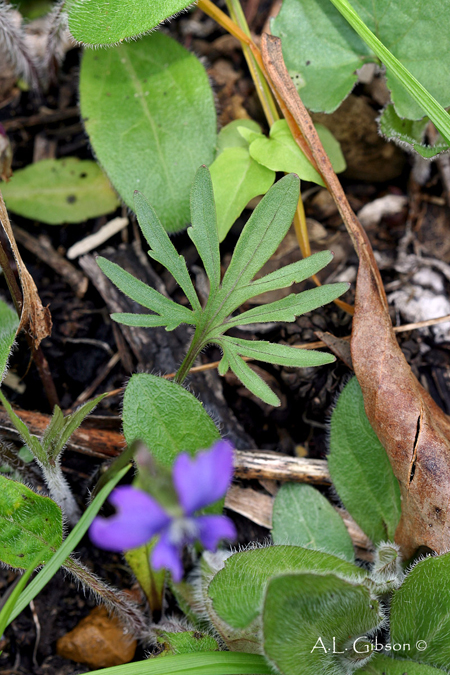
Chasmogamous flowering habit by Andrew Gibson, "Buckeye Botanist" website
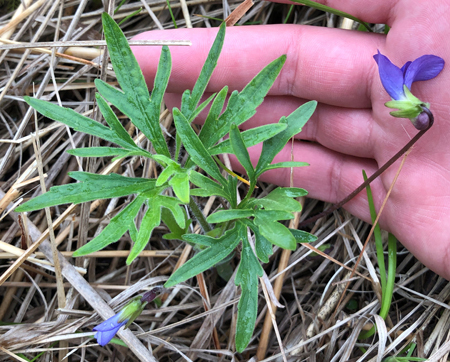
Chasmogamous flowering habit by Andrew Gibson
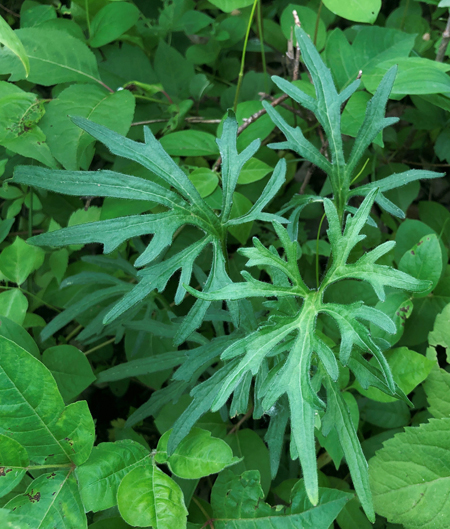
Leaf during chasmogamous flower by Andrew Gibson
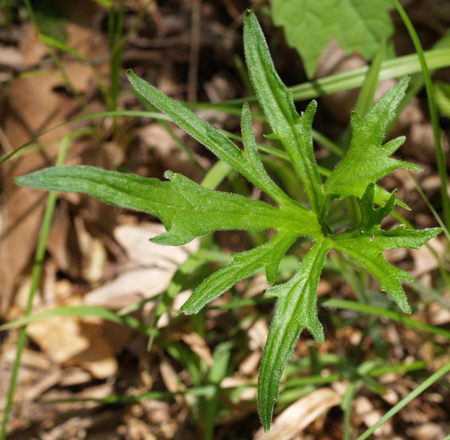
Leaf during chasmogamous fruit by Harvey Ballard

Chasmogamous flower profile view by Andrew Gibson
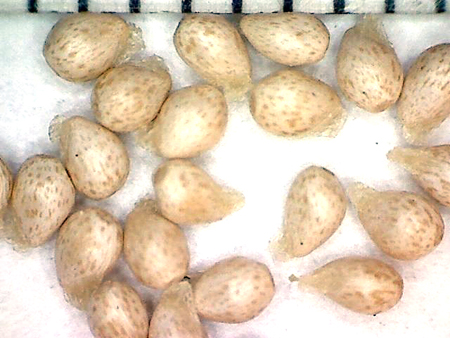
Seeds from herbarium specimen: Transplanted from MI, Washtenaw Co., Ballard 15-045Y (BHO)

Seeds from herbarium specimen: Transplanted from OH, Adams Co., Ballard 15-040Z (BHO)
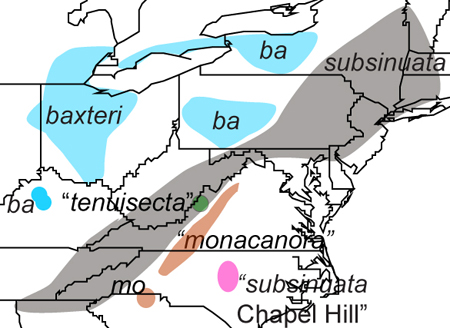
Map of the Subsinuata species group by Harvey Ballard